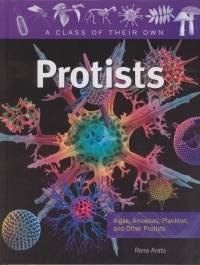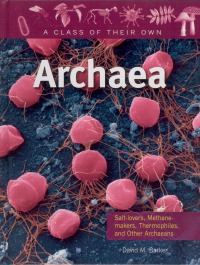| ________________
CM . . . . Volume XVI Number 41. . . .June 25, 2010. 
 |
Protists: Algae, Amoebas, Plankton, and Other Protists. (A Class of Their Own).
Rona Arato.
St. Catharines, ON: Crabtree, 2010.
32 pp., pbk. & hc., $11.95 (pbk.), $20.76 (RLB.).
ISBN 978-0-7787-5391-9 (pbk.), ISBN 978-0-7787-5377-3 (RLB.).
Subject Headings:
Protista-Classification-Juvenile literature.
Protista-Juvenile literature.
Grade 5-8 / Ages 10-14.
Review by Barbara McMillan.
****/4
|
 |
Archaea: Salt-lovers, Methane-makers, Thermophiles, and Other Archaeans (A Class of Their Own).
David M. Barker.
St. Catharines, ON: Crabtree, 2010.
32 pp., pbk. & hc., $11.95 (pbk.), $20.76 (RLB.).
ISBN 978-0-7787-5387-2 (pbk.), ISBN 978-0-7787-5373-5 (RLB.).
Subject Headings:
Archaebacteria-Classification-Juvenile literature.
Archaebacteria-Juvenile literature.
Grade 5-8 / Ages 10-14.
Review by Barbara McMillan.
****/4
|
 |
Animals: Mammals, Birds, Reptiles, Amphibians, Fish, and Other Animals. (A Class of Their Own).
Shar Levine & Leslie Johnstone.
St. Catharines, ON: Crabtree, 2010.
32 pp., pbk. & hc., $11.95 (pbk.), $20.76 (RLB.).
ISBN 978-0-7787-5386-5 (pbk.), ISBN 978-0-7787-5372-8 (RLB.).
Subject Headings:
Animals-Classification-Juvenile literature.
Animals-Juvenile literature.
Grade 5-8 / Ages 10-14.
Review by Barbara McMillan.
****/4
|
 |
Plants: Flowering Pants, Ferns, Mosses, and Other Plants. (A Class of Their Own).
Shar Levine & Leslie Johnstone.
St. Catharines, ON: Crabtree, 2010.
32 pp., pbk. & hc., $11.95 (pbk.), $20.76 (RLB.).
ISBN 978-0-7787-5390-2 (pbk.), ISBN 978-0-7787-5376-6 (RLB.).
Subject Headings:
Plants-Classification-Juvenile literature.
Plants-Juvenile literature.
Grade 5-8 / Ages 10-14.
Review by Barbara McMillan.
****/4
|
 |
Bacteria: Staph, Strep, Clostridium, and Other Bacteria. (A Class of Their Own).
Judy Wearing.
St. Catharines, ON: Crabtree, 2010.
32 pp., pbk. & hc., $11.95 (pbk.) $20.76 (RLB.).
ISBN 978-0-7787-5388-9 (pbk.), ISBN 978-0-7787-5374-2 (RLB.).
Subject Headings:
Bacteria-Classification-Juvenile literature.
Bacteria-Juvenile literature.
Grade 5-8 / Ages 10-14.
Review by Barbara McMillan.
****/4
|
 |
Fungi: Mushrooms, Toadstools, Molds, Yeasts, and Other Fungi. (A Class of Their Own).
Judy Wearing.
St. Catharines, ON: Crabtree, 2010.
32 pp., pbk. & hc., $11.95 (pbk.), $20.76 (RLB.).
ISBN 978-0-7787-5389-6 (pbk.), ISBN 978-0-7787-5375-9 (RLB.).
Subject Headings:
Fungi-Classification-Juvenile literature.
Fungi-Juvenile literature.
Grade 5-8 / Ages 10-14.
Review by Barbara McMillan.
****/4
|
| |
|

excerpt:
Scientists have discovered that moths retain memories of what they sensed as caterpillars. Researchers used mild electric shocks to train tobacco hornworm caterpillars to avoid the smell of a chemical. After developing into full-grown moths, 75 percent of the creatures exposed to the shocks avoided the smell of that chemical. These findings indicate that although the moth looks as if it was rebuilt entirely while undergoing its metamorphosis from larva to adult, parts of its nervous system remain intact. (From Animals.)
Archaeans have a reputation for living in very nasty habitats, such as the near-boiling waters of the hot springs of Yellowstone Park. They also live deep in oil wells, in the dark crushing pressure of the ocean floor, in scalding water, in very salty water, and in rock miles beneath the ground. Scientists are also discovering them in less extreme habitats such as ocean water, soil, compost piles, and lake water where they live alongside bacteria and many other organisms. (From Archaea.)
One coccus species [of bacteria] has an amazing ability to survive radiation from the Sun or from nuclear waste. This makes it useful for cleaning up some of the most difficult pollution. Deinococcus radiodurans is featured in the Guinness Book of World Records as the “world’s toughest bacterium.”…This bacterium has the ability to survive 1,000 times the amount of radiation that humans can…Scientists are using genetic engineering to put the “pollution eating” genes of other bacteria into D. radiodurans. The result is a bacterium that both “eats” pollution and survives some of the worst conditions on Earth. (From Bacteria.)
There are several fungi that produce [the antibiotic] penicillin. While penicillin is of great benefit to us, that is not why the fungus produces it. The fungus produces it because it is of benefit to itself! Penicillin benefits the fungus by killing bacteria around it. Fewer organisms growing around the fungus results in less competition for food. This means more food for the fungus. (From Fungi.)
Plants grown in the wild can be very different from those carefully bred and cultivated by growers over many generations. Growers choose individual plants with desirable characteristics and deliberately breed them to get a plant that does what they want. Bananas are a good example of the results of this practice. Wild varieties are smaller than those found in grocery stores, and they contain large seeds from which the plant can be grown. Growers breed and crossbreed different varieties of the plant to produce the plantains and sweet bananas found in supermarkets today. Cultivated bananas, those bred by farmers, are sterile. This means that they have no seeds and the plant could no longer exist without human intervention. (From Plants.)
It’s hard to know how many individual organisms there are of any group on the planet, but scientists estimate that trillions of individual protist organisms are probably alive at any given moment. Many are important sources of food, for humans and other animals…It’s true that some protists cause dreadful human diseases such as malaria, dysentery, and African sleeping sickness, and others, such as the dinoflagellates that cause the “red tide,” kill sea life. Most protists are harmless, however, and many, such as the paramecia that eat harmful bacteria, are very helpful. Protists are used in food, cosmetics, and medicine. They are also invaluable in research, as scientists study them to learn more about Earth’s ecosystems and human disease. (From Protists.)
From Atlantic Canada to British Columbia, the majority of Canadian students in Grade 6 science are exposed to the diversity of life on Earth and the ways in which this great variety of organisms have been classified. The authors of Crabtree’s “A Class of Their Own” series have adopted a six kingdom classification system that reflects the three domains proposed in 1990 by Woese, Kandler, and Wheelis. These are Archaea, Bacteria, and Eucarya. Eucarya is composed of eukaryotes, which are organisms with a distinct cell nucleus and other structures that are membrane bound. Currently, eukaryotic organisms are sorted into four taxonomic kingdoms; Animalia, Plantae, Fungi, and Protista. Thus, the titles of the six books in the series.
Animals, Archaea, Bacteria, Fungi, Plants and Protists are well illustrated, thoughtfully designed, and written to inform and interest youth and adults alike (see excerpts above). Each book is 48 pages in length. Contained within these pages are an introduction to the kingdom featured, a brief overview of biological classification, three to five chapters that focus upon phyla and classes of organisms within the kingdom, a glossary, a list of websites that provide additional information about the kingdom and its members, an index, and a paragraph about the books author or pair of authors.
Collectively, the series helps readers to understand the defining characteristics of the kinds of organisms within each taxonomic group, the habitats and ecological niches members of each group occupy, their benefit to humans, their often controversial use by humans, and the problems that can arise as a consequence of the human illnesses and diseases particular species either cause or transmit. This information provides readers with a precise and fascinating introduction to the diversity of life on Earth. Moreover, the authors address many of the knowledge outcomes in Grade 6 science curricula that were based upon the 1997 Common Framework of Science Learning Outcomes developed for the Council of Ministers of Education, Canada. As such, Crabtree’s “A Class of Their Own” series should be considered by elementary and middle school librarians as an important up to date addition to their school library collection.
Highly Recommended.
Barbara McMillan is a teacher educator and a professor of science education in the Faculty of Education, the University of Manitoba.

To comment on this title or this review, send mail to
cm@umanitoba.ca.
Copyright © the Manitoba Library Association. Reproduction for personal use is permitted only if this copyright notice is maintained. Any other reproduction is prohibited without permission.
NEXT REVIEW |
TABLE OF CONTENTS FOR THIS ISSUE- June 25, 2010.
AUTHORS |
TITLES |
MEDIA REVIEWS |
PROFILES |
BACK ISSUES |
SEARCH |
CMARCHIVE |
HOME |





